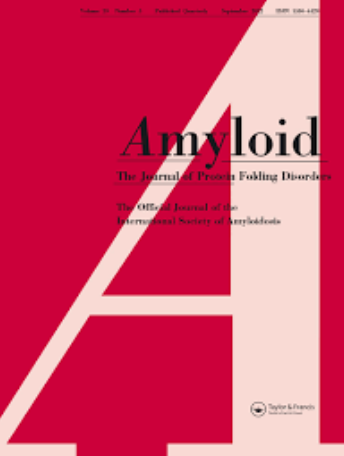免疫球蛋白轻链淀粉样变模拟球肌萎缩性侧索硬化症。
IF 5.2
2区 医学
Q1 BIOCHEMISTRY & MOLECULAR BIOLOGY
Amyloid-Journal of Protein Folding Disorders
Pub Date : 2023-09-01
DOI:10.1080/13506129.2022.2163891
引用次数: 0
摘要
本文章由计算机程序翻译,如有差异,请以英文原文为准。
Immunoglobulin light-chain amyloidosis mimicking bulbar amyotrophic lateral sclerosis.
A 62-year-old man experienced involuntary weight loss (-36% in the last 6months) followed by dysphagia and dysphonia. He then developed painful and burning paresthaesia in his lower limbs. He also experienced progressive difficulty in walking due to postural dizziness. Clinical examination found an atrophic tongue with profuse fasciculations (Figure 1), few fasciculations in the four limbs, abductor pollicis brevis weakness, distal hypoesthesia in the four limbs, general areflexia, and neurogenic orthostatic hypotension. Nerve conduction studies and needle electromyography showed mixed axonal and demyelinating sensorimotor polyneuropathy, bilateral carpal tunnel syndrome, as well as widespread fasciculations and fibrillations in the bulbar, cervical, thoracic and lumbar regions. IgG lambda monoclonal immunoglobulin (2 g/L), elevated serum lambda/kappa ratio (10.4, N< 1.65) and bone marrow clonal plasma cell infiltration were found, along with tissue amyloid deposition of lambda light chains accessed by immunofluorescence staining of the minor salivary glands. The final diagnosis was immunoglobulin light-chain amyloidosis complicated by lower motor neuron dysfunction. After treatment (melphalan, ixazomib and dexamethasone, followed by daratumumab) all neurological signs/symptoms improved including bulbar signs despite the absence of complete hematological response. To our knowledge the case presented herein is the first of immunoglobulin light-chain amyloidosis with bulbar onset mimicking motor neuron disease at initial presentation. For the two patients with an initial diagnosis of motor neuron disease revealing an immunoglobulin light-chain amyloidosis described in the literature the first symptom was lower limb weakness [1,2]. However, patients with systemic amyloidosis disease are reported to present with bulbar signs but during the course of the disease [3]. Also, motor neuropathy with early-onset severe bulbar involvement has been described for familial amyloid neuropathy (due to mutations in TTR [4,5] or GSN (encodes gelsolin)) [6]. The present report highlights that bulbar signs mimicking bulbar amyotrophic lateral sclerosis could be the first manifestation of immunoglobulin light-chain amyloidosis and underlined that dedicated workup should be performed in all atypical motor neuron diseases associated with sensory abnormalities, neuropathic pain or autonomic dysfunction. Acknowledgments
求助全文
通过发布文献求助,成功后即可免费获取论文全文。
去求助
来源期刊

Amyloid-Journal of Protein Folding Disorders
生物-生化与分子生物学
CiteScore
10.60
自引率
10.90%
发文量
48
审稿时长
6-12 weeks
期刊介绍:
Amyloid: the Journal of Protein Folding Disorders is dedicated to the study of all aspects of the protein groups and associated disorders that are classified as the amyloidoses as well as other disorders associated with abnormal protein folding. The journals major focus points are:
etiology,
pathogenesis,
histopathology,
chemical structure,
nature of fibrillogenesis;
whilst also publishing papers on the basic and chemical genetic aspects of many of these disorders.
Amyloid is recognised as one of the leading publications on amyloid protein classifications and the associated disorders, as well as clinical studies on all aspects of amyloid related neurodegenerative diseases and major clinical studies on inherited amyloidosis, especially those related to transthyretin. The Journal also publishes book reviews, meeting reports, editorials, thesis abstracts, review articles and symposia in the various areas listed above.
 求助内容:
求助内容: 应助结果提醒方式:
应助结果提醒方式:


